PONTIAC GRAND AM 1997 Owners Manual
Manufacturer: PONTIAC, Model Year: 1997, Model line: GRAND AM, Model: PONTIAC GRAND AM 1997Pages: 371, PDF Size: 18.14 MB
Page 331 of 371
![PONTIAC GRAND AM 1997 Owners Manual 90,000 Miles (150 000 km)
c] Rotate tires. See “Tire Inspection and
Rotation’’ in the Index for proper rotation
pattern and additional infomation.
(See footnote
+.) (Also see footnote PONTIAC GRAND AM 1997 Owners Manual 90,000 Miles (150 000 km)
c] Rotate tires. See “Tire Inspection and
Rotation’’ in the Index for proper rotation
pattern and additional infomation.
(See footnote
+.) (Also see footnote](/img/50/40837/w960_40837-330.png)
90,000 Miles (150 000 km)
c] Rotate tires. See “Tire Inspection and
Rotation’’ in the Index for proper rotation
pattern and additional infomation.
(See footnote
+.) (Also see footnote ++.)
DATE SERVICED BY ACTUAL MILEAGE
97,500 Miles (162 500 km)
0 Change engine oil and filter (or every
12 months, whichever occurs first).
An Emission Control Service.
0 Lubricate chassis components (or every
12 months, whichever occurs first).
(See footnote
#.)
0 Rotate tires. See “Tire Inspection and
Rotation” in the Index for proper rotation
pattern and additional information.
(See footnote
+.)
DATE SERVICED BY ACTUAL MILEAGE
Page 332 of 371
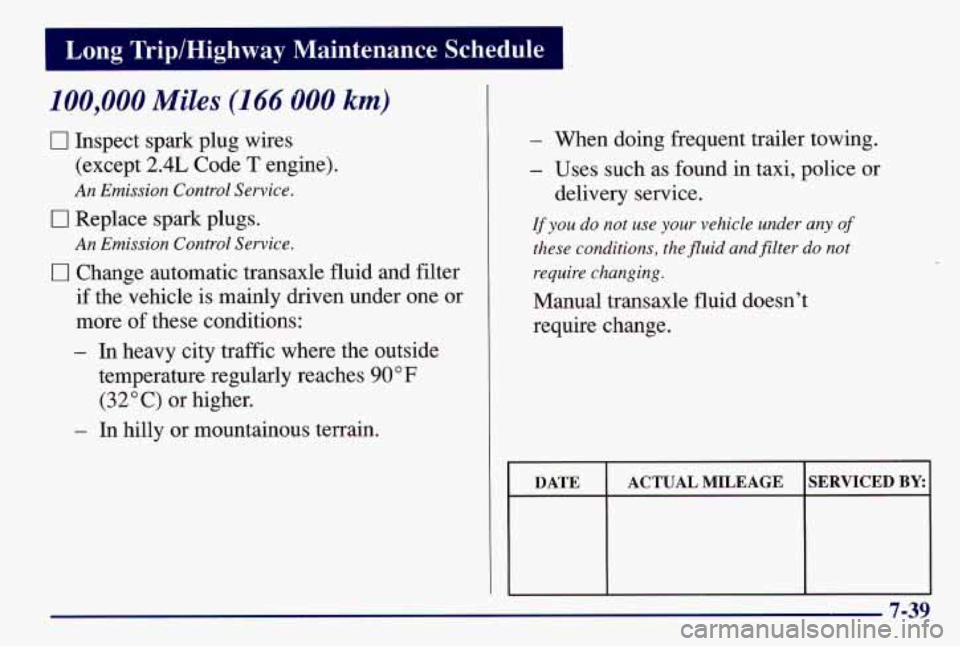
100,000 Miles (166 800 km)
0 Inspect spark plug wires
(except
2.4L Code T engine).
An Emission Control Service.
0 Replace spark plugs.
0 Change automatic transaxle fluid and filter
if the vehicle is mainly driven under one or
more
of these conditions:
- In heavy city traffic where the outside
temperature regularly reaches
90 OF
(32 O C) or higher.
An Emission Control Service.
-
In hilly or mountainous terrain.
- When doing frequent trailer towing.
- Uses such as found in taxi, police or
delivery service.
If you do not use your vehicle under any of
these conditions, the fluid and filter do not
require changing.
Manual transaxle fluid doesn’t
require change.
7-39
Page 333 of 371
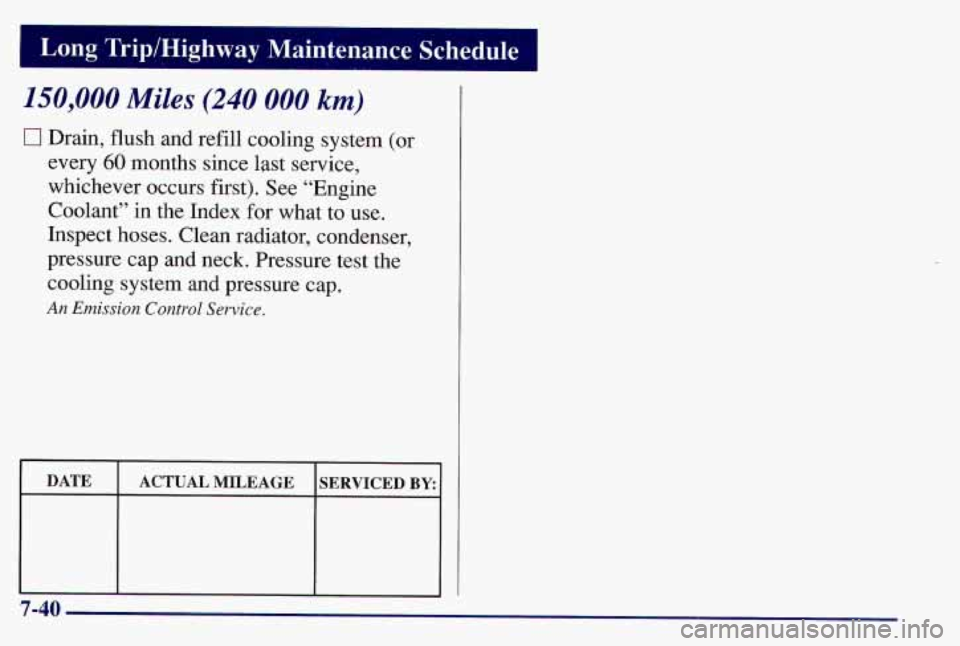
150,000 Miles (240 000 km)
17 Drain, flush and refill cooling system (or
every 60 months since last service,
whichever occurs first). See “Engine
Coolant” in
the Index for what to use.
Inspect hoses. Clean radiator, condenser,
pressure cap and neck. Pressure test the.
cooling system and pressure cap.
An Emission Control Service.
DATE
SERVICED BY ACTUAL MILEAGE
7-40
Page 334 of 371
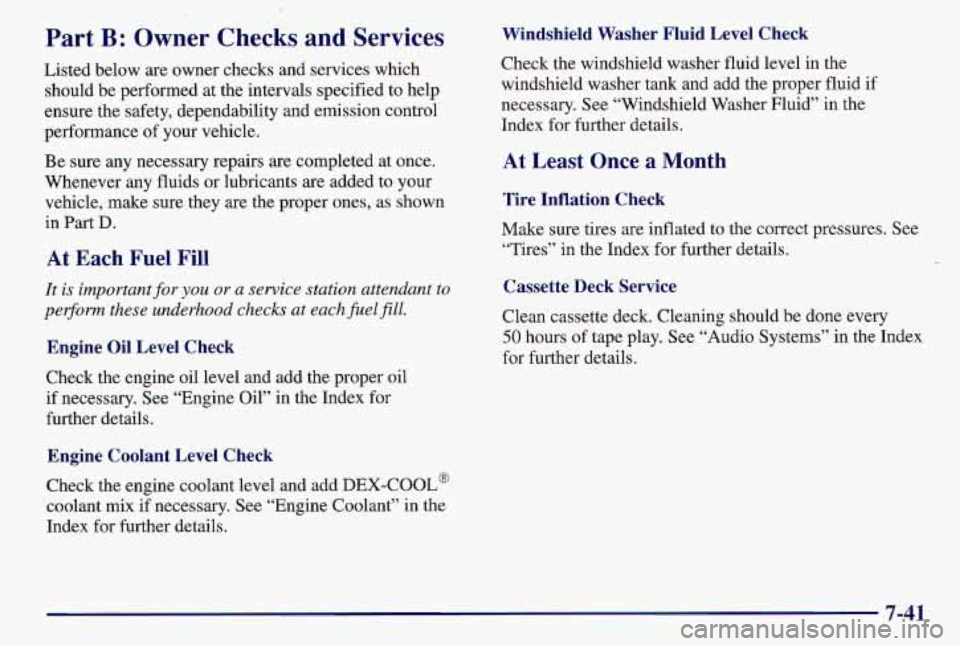
Part B: Owner Checks and Services
Listed below are owner checks and services which
should be performed at the intervals specified to help
ensure the safety, dependability and emission control
performance
of your vehicle.
Be sure any necessary repairs are completed at once.
Whenever any fluids or lubricants are added to your
vehicle, make sure they
are the proper ones, as shown
in
Part D.
At Each Fue- - --II
It is important for you or a service station attendant to
per$orm these underhood checks at each fie1
fill.
Engine Oil Level Check
Check the engine oil level and add the proper oil
if necessary, See “Engine Oil” in the Index for
further details.
Engine Coolant Level Check
Check the engine coolant level and add DEX-COOL@
coolant mix if necessary. See “Engine Coolant’’ in the
Index for further details.
Windshield Washer Fluid Level Check
Check the windshield washer fluid level in the
windshield washer tank and add the proper fluid
if
necessary. See “Windshield Washer Fluid” in the
Index for further details.
At Least Once a Month
Tire Inflation Check
Make sure tires are inflated to the correct pressures. See
“Tires” in the Index for further details.
Cassette Deck Service
Clean cassette deck. Cleaning should be done every
50 hours of tape play. See “Audio Systems” in the Index
for further details.
7-41
Page 335 of 371
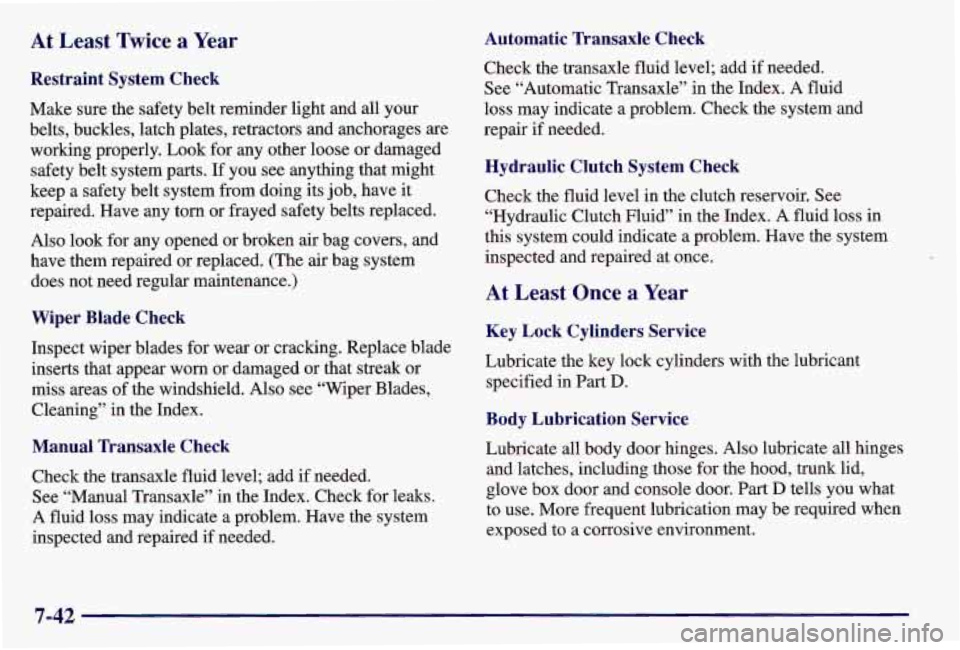
At Least Twice a Year
Restraint System Check
Make sure the safety belt reminder light and all your
belts, buckles, latch plates, retractors and anchorages are
working properly. Look for any other loose or damaged
safety belt system parts. If you see anything that might
keep a safety belt system from doing its job, have it
repaired. Have any torn or frayed safety belts replaced.
Also look for any opened or broken air bag covers, and
have them repaired or replaced. (The air bag system
does not need regular maintenance.)
Wiper Blade Check
Inspect wiper blades for wear or cracking. Replace blade
inserts that appear worn or damaged or that streak or
miss areas of the windshield. Also see “Wiper Blades,
Cleaning” in the Index.
Manual Transaxle Check
Check the transaxle fluid level; add if needed.
See “Manual Transaxle” in the Index. Check for leaks.
A fluid
loss may indicate a problem. Have the system
inspected and repaired if needed.
Automatic Transaxle Check
Check the transaxle fluid level; add if needed.
See “Automatic Transaxle” in the Index. A fluid
loss may indicate a problem. Check the system and
repair
if needed.
Hydraulic Clutch System Check
Check the fluid level in the clutch reservoir. See
“Hydraulic Clutch Fluid” in the Index. A fluid loss in
this system could indicate a problem. Have the system
inspected and repaired at once.
At Least Once a Year
Key Lock Cylinders Service
Lubricate the key lock cylinders with the lubricant
specified in
Part D.
Body Lubrication Service
Lubricate all body door hinges. Also lubricate all hinges
and latches, including those for the hood, trunk lid,
glove box door and console door. Part
D tells you what
to use. More frequent lubrication may be required when
exposed to a corrosive environment.
7-42
Page 336 of 371
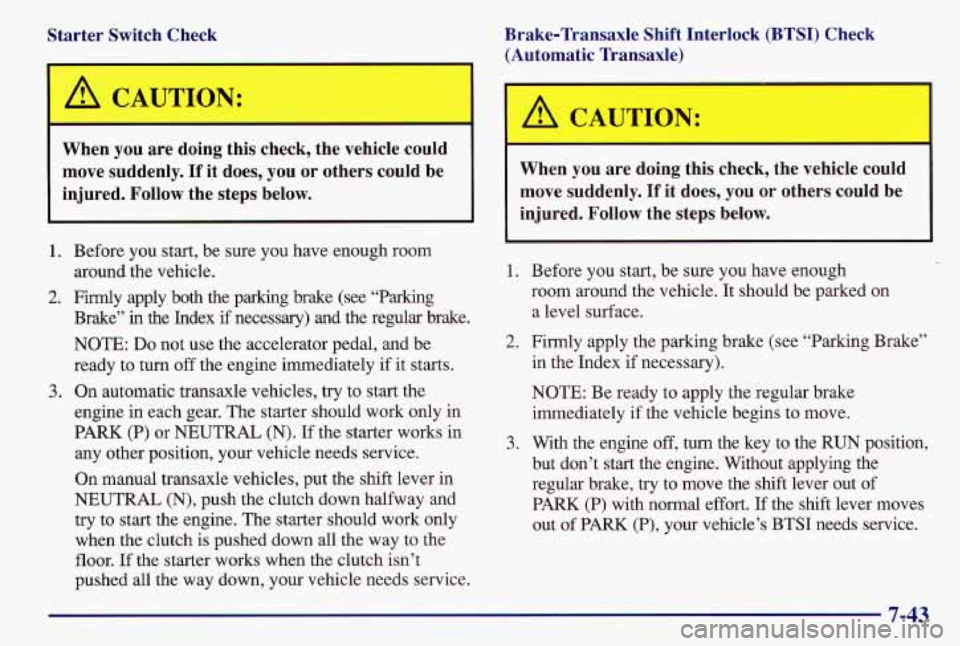
Starter Switch Check
A CAUTION: ,
I
When you are doing this check, the vehicle could
move suddenly.
If it does, you or others could be
injured. Follow the steps below.
1.
2.
3.
Before you start, be sure you have enough room
around the vehicle.
Firmly apply both the parking brake (see “Parking Brake”
in the Index if necessary) and the regular brake.
NOTE:
Do not use the accelerator pedal, and be
ready to turn off the engine immediately if
it starts.
On automatic transaxle vehicles, try
to start the
engine in each gear. The starter should work only in
PARK
(P) or NEUTRAL (N). If the starter works in
any other position, your vehicle needs service.
On manual transaxle vehicles, put the shift lever in
NEUTRAL
(N), push the clutch down halfway and
try to start the engine. The starter should work only
when the clutch is pushed down all the way to the
floor.
If the starter works when the clutch isn’t
pushed all the way down, your vehicle needs service.
Brake-Transaxle Shift Interlock (BTSI) Check
(Automatic Transaxle)
A CAUTION:
When you are doing this check, the vehicle could
move suddenly. If
it does, you or others could be
injured. Follow the steps below.
1. Before you start, be sure you have enough
room around the vehicle.
It should be parked on
a level surface.
2. Firmly apply the parking brake (see “Parking Brake”
in the Index if necessary).
NOTE: Be ready to apply the regular brake
immediately if the vehicle begins to move.
3. With the engine off, turn the key to the RUN position,
but don’t start the engine. Without applying the
regular brake, try to move the shift lever out
of
PARK (P) with normal effort. If the shift lever moves
out of PARK (P), your vehicle’s BTSI needs service.
7-43
Page 337 of 371
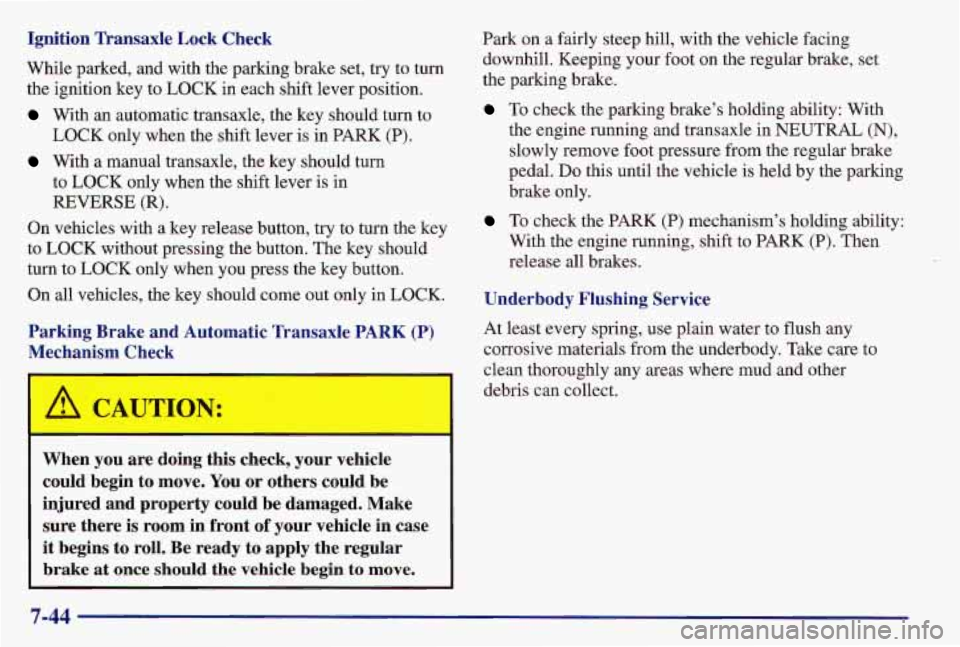
Ignition Transaxle Lock Check
While parked, and with the parking brake set, try to turn
the ignition key to LOCK in each shift lever position.
With an automatic transaxle, the key should turn to
LOCK only when the shift lever is in PARK
(P).
With a manual transaxle, the key should turn
to LOCK only when the shift lever is in
REVERSE (R).
On vehicles with a key release button, try to turn the key
to LOCK without pressing the button. The key should
turn to LOCK only when you press the key button.
On all vehicles, the key should come out only in LOCK.
Parking Brake and Automatic Transaxle PARK (P)
Mechanism Ck :k
A CAUTION:
When you are doing this check, your vehicle
could begin to move. You or others could be
injured and property could be damaged. Make
sure there
is room in front of your vehicle in case
it begins to roll. Be ready to apply the regular
brake at once
should the vehicle begin to move.
Park on a fairly steep hill, with the vehicle facing
downhill. Keeping your foot on the regular brake, set
the parking brake.
To check the parking brake's holding ability: With
the engine running and transaxle in NEUTRAL
(N),
slowly remove foot pressure from the regular brake
pedal.
Do this until the vehicle is held by the parking
brake only.
To check the PARK (P) mechanism's holding ability:
With the engine running, shift to PARK (P). Then
release all brakes.
Underbody Flushing Service
At least every spring, use plain water to flush any
corrosive materials from the underbody. Take care to
clean thoroughly any areas where mud and other
debris
can collect.
7-44
Page 338 of 371
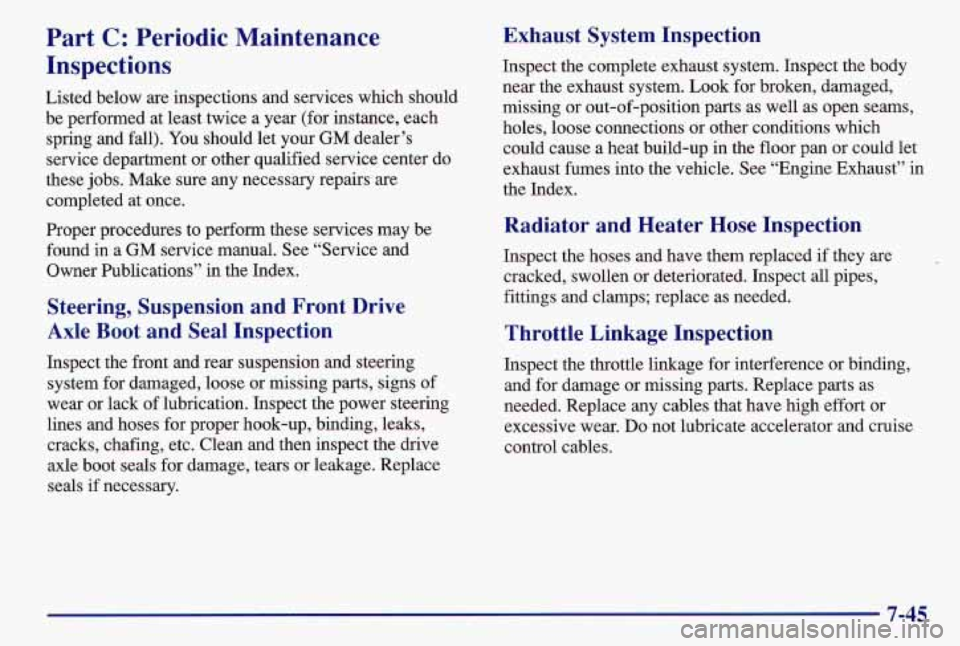
Part C: Periodic Maintenance
Inspections
Listed below are inspections and services which should
be performed at least twice a year (for instance, each
spring and fall). You should let your GM dealer’s
service department or other qualified service center
do
these jobs. Make sure any necessary repairs are
completed at once.
Proper procedures to perform these services may be
found in a GM service manual. See “Service and
Owner Publications” in the Index.
Steering, Suspension and Front Drive
Axle Boot and Seal Inspection
Inspect the front and rear suspension and steering
system for damaged, loose or missing parts, signs of
wear or lack
of lubrication. Inspect the power steering
lines and hoses for proper hook-up, binding, leaks,
cracks, chafing, etc. Clean and then inspect the drive
axle boot seals for damage, tears or leakage. Replace
seals if necessary.
Exhaust System Inspection
Inspect the complete exhaust system. Inspect the body
near the exhaust system. Look for broken, damaged,
missing or out-of-position parts as well as open seams,
holes, loose connections or other conditions which
could cause a heat build-up in the floor pan or could let
exhaust fumes into the vehicle. See “Engine Exhaust’’ in
the Index.
Radiator and Heater Hose Inspection
Inspect the hoses and have them replaced if they are
cracked, swollen or deteriorated. Inspect all pipes,
fittings and clamps; replace as needed.
Throttle Linkage Inspection
Inspect the throttle linkage for interference or binding,
and for damage or missing parts. Replace parts as
needed. Replace any cables that have high effort or
excessive wear.
Do not lubricate accelerator and cruise
control cables.
7-45
Page 339 of 371
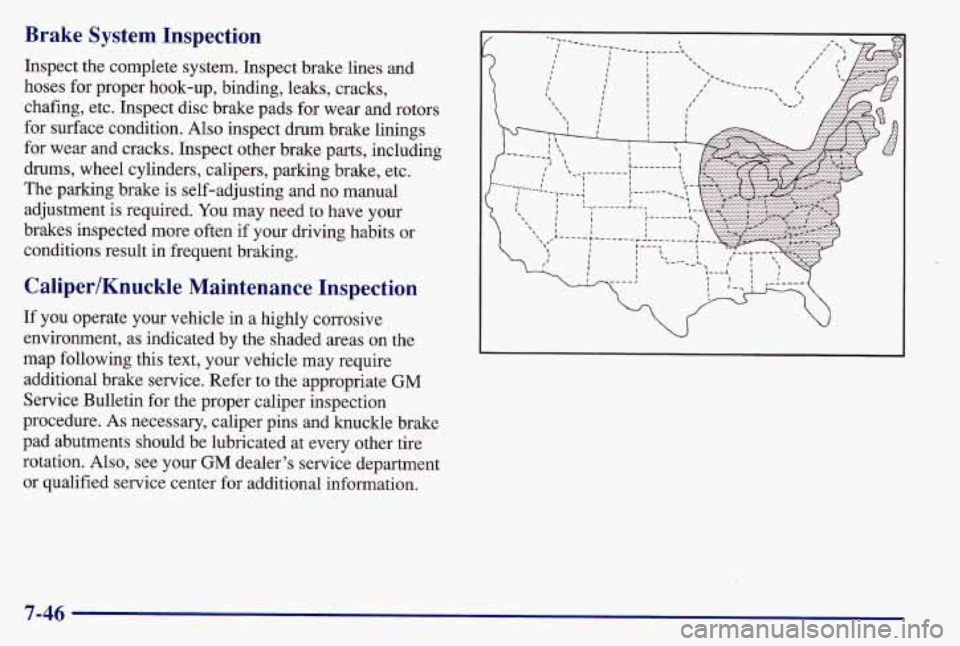
Brake System Inspection
Inspect the complete system. Inspect brake lines and
hoses for proper hook-up, binding, leaks, cracks,
chafing, etc. Inspect disc brake pads for wear and rotors
for surface condition. Also inspect drum brake linings
for wear and cracks. Inspect other brake parts, including
drums, wheel cylinders, calipers, parking brake, etc.
The parking brake is self-adjusting and
no manual
adjustment is required.
You may need to have your
brakes inspected more often
if your driving habits or
conditions result in frequent braking.
Caliper/Knuckle Maintenance Inspection
If you operate your vehicle in a highly corrosive
environment, as indicated by the shaded areas on the
map following this text, your vehicle may require
additional brake service. Refer to the appropriate
GM
Service Bulletin for the proper caliper inspection
procedure. As necessary, caliper pins and knuckle brake
pad abutments should be lubricated at every other tire
rotation. Also, see your
GM dealer’s service department
or qualified service center for additional information.
7-46
Page 340 of 371
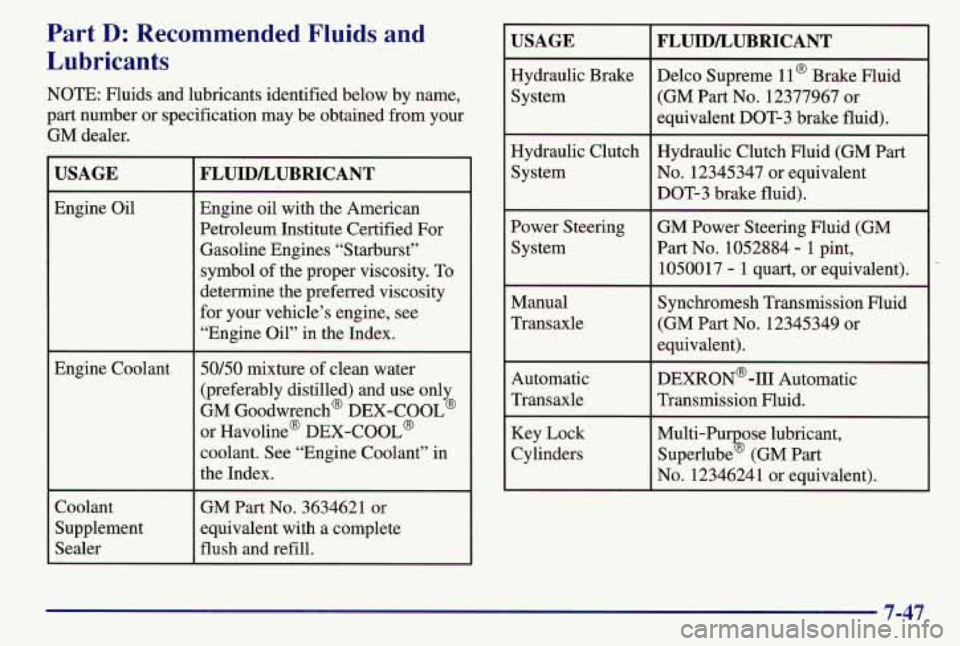
Part D: Recommended Fluids and
Lubricants
NOTE: Fluids and lubricants identified below by name,
part number or specification may be obtained from your
GM dealer.
USAGE
Engine Oil
Engine Coolant
Coolant Supplement
Sealer
FLUIDLUBRICANT
Engine oil with the American
Petroleum Institute Certified For
Gasoline Engines “Starburst”
symbol of the proper viscosity.
To
determine the preferred viscosity
for your vehicle’s engine, see
“Engine Oil” in the Index.
50/50 mixture of clean water
(preferably distilled) and use only
GM Goodwrench@ DEX-COOL@
or Havoline@ DEX-COOL@
coolant. See “Engine Coolant” in
the Index.
GM Part No. 3634621 or
equivalent with a complete
flush and refill.
USAGE
Hydraulic Brake
System
Hydraulic Clutch System
Power Steering
System
Manual
Transaxle
Automatic
Transaxle Key Lock
Cylinders
FLUID/LUBRICANT
Delco Supreme 11 @ Brake Fluid
(GM Part No. 12377967 or
equivalent DOT-3 brake fluid).
Hydraulic Clutch Fluid
(GM Part
No. 12345347 or equivalent DOT-3 brake fluid).
GM Power Steering Fluid (GM
Part No. 1052884
- 1 pint,
1050017
- 1 quart, or equivalent).
Synchromesh Transmission Fluid
(GM Part No. 12345349
or
equivalent).
DEXR0N’-I11 Automatic
Transmission Fluid.
Multi-Pu ose lubricant,
Superlube
% (GM Part
No. 12346241 or equivalent).
7-47